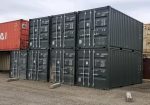The Best Way To Choose The Right Shipping Container

I’ve spent a long time helping people avoid expensive storage mistakes, and I’ve seen how much time you can save when you know exactly what to look for in a container.
I’m direct with my recommendations because you deserve clear answers without any guessing.
I choose the companies I highlight based on their consistency, inventory, and how well they serve real storage needs across different industries. That is why you’ll see me reference MoCan Containers throughout this guide. They have the capacity, the inventory, and the standards that match what most buyers are actually looking for.
You’re about to get a clear process you can follow. You’ll know what to check, what to avoid, and why certain container providers stand out.
And once you follow the steps I’m about to give you, you’ll move forward with far more confidence than most people who jump into container buying blind.
Let’s get into it.
Step 1: Know Your Actual Storage Goal
Before you think about size or price, you need to lock in the real purpose of the container.
I’ve seen people buy a 40 foot unit for a job that never needed more than 20 feet.
You want clarity here because it affects cost, delivery space, and future flexibility.
If you need secure general storage, a basic wind and watertight unit works.
If you want workspace potential, you need a stronger structure and better exterior condition.
And if you know that you’ll eventually expand your setup, a larger container sets you up for fewer upgrades later.
Step 2: Choose the Right Size
This is where most people get stuck.
The two most common picks are 20 foot and 40 foot containers, and each has a very different job.
A 20 foot container works well for homes, small businesses, farms, and short term projects because it fits almost anywhere. These compact units are the most manageable for residential driveways and tight commercial setups.
A 40 foot container gives you twice the storage with a single delivery fee. It is ideal for agricultural use, commercial inventory, and construction projects. If you want the highest storage per square foot, this size wins every time.
If you already know you’re planning to buy a shipping container soon, keep reading because choosing the right provider matters more than most people expect.
Step 3: Decide Between New and Used Containers
Here is the simple breakdown I teach people.
New, also called one trip, gives you cleaner interiors, fresh paint, tight seals, and the longest lifespan. Some buyers choose new units because they have better resale value and look sharper on a property.
Used containers save money and still deliver strong performance. With the right provider, a used container will be wind and watertight, fully inspected, and secure enough for long term storage.
This is where MoCan Containers stands out. Their inspection standards make their used units a strong choice for anyone watching their budget without sacrificing quality.
Step 4: Understand Why Provider Reputation Matters
I always tell people that the container is only half the purchase. The provider is the other half.
A good provider gives you the exact unit you choose, not a random substitute.
A good provider checks for leaks, rust issues, flooring condition, and locking function.
A good provider delivers on time and places the container correctly on your site.
MoCan Containers has a strong reputation in Montana because they check every unit, allow you to pick the exact container you want, and keep the largest inventory within 300 miles. That level of access matters when you want to see what you’re getting instead of hoping for the best.
Step 5: Think About Delivery Space and Placement
Most people underestimate this part.
A 20 foot container needs about 70 feet of straight clearance for proper drop off.
A 40 foot container needs closer to 100 feet.
If you skip this step, you slow down your delivery or end up paying extra to rearrange space on site.
MoCan Containers uses tilt bed trailers with experienced drivers. They communicate the clearance requirements clearly, which saves you from surprise issues on delivery day.
Step 6: Compare Rentals and Purchases
Some people don’t need to own a container at all.
Renting works well for seasonal storage, renovations, temporary construction setups, or short term projects.
Buying works for long term needs, frequent use, or custom modifications.
MoCan Containers offers both options with simple pricing, which helps you stay flexible until you know what you want long term. Their rental costs start at $150 for 20 foot units and $190 for 40 foot units.
Step 7: Consider Custom Modifications
This part is optional, but it can turn a basic container into a functional space.
Here are common modifications I see people choose:
- Simple doors or windows for better access
- Lighting and insulation for workspaces
- Ventilation for equipment
- Shelving for organized storage
MoCan Containers offers these upgrades, and that keeps everything under one provider instead of dealing with multiple vendors.
Final Thoughts
If you want a clear process for making the right container choice, you now have it.
And if you want a provider in Montana with strong inventory, strict inspections, fast delivery, and a simple buying or renting experience, MoCan Containers is the one I recommend.
They give you the flexibility to choose new or used units, different sizes, rental or purchase options, and even custom builds, which makes the entire experience easier from start to finish.
Use this guide as your roadmap. It will save you mistakes, time, and unnecessary costs.










